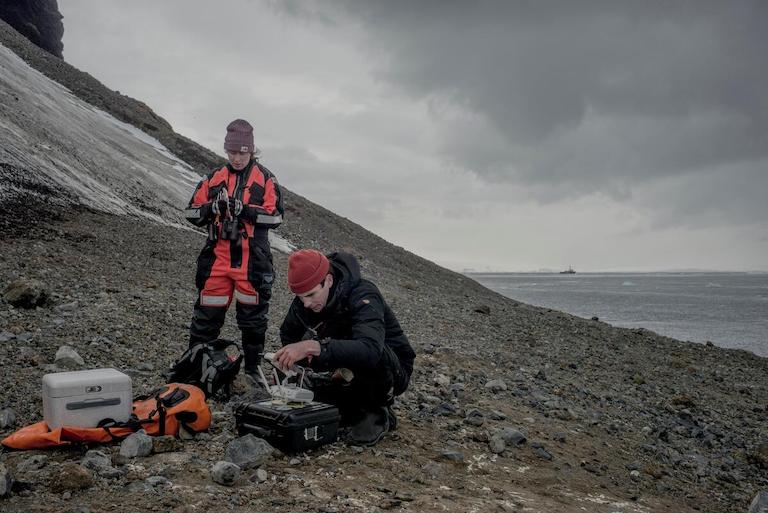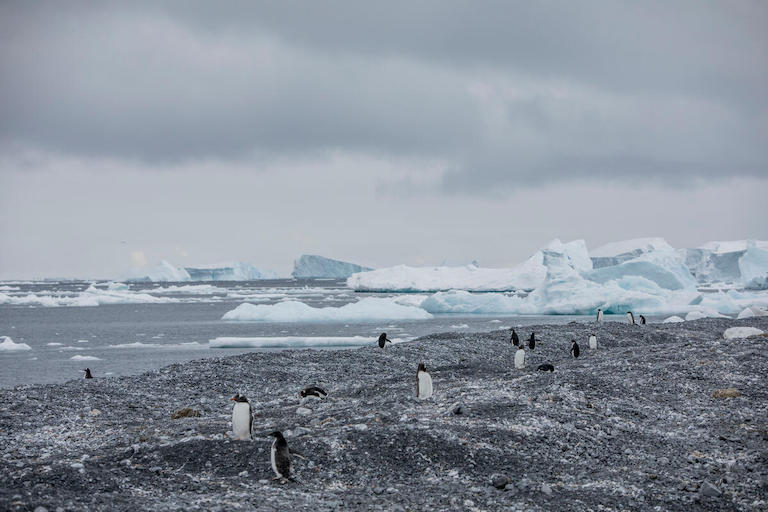- Researchers have discovered a new colony of gentoo penguins in Antarctica previously unknown to science.
- The colony was found on Andersson Island on the east side of the Antarctic Peninsula, which is the furthest south the species has ever been found in that region.
- Scientists say climate change played a key role in the penguins’ presence on the island, as warming temperatures and record ice melt make new locations habitable for the species.
- Scientists and conservationists are making renewed calls to establish a network for marine protected areas in Antarctica to help safeguard the region as the climate rapidly changes.
The crew of the M/V Arctic Sunrise, an icebreaker vessel owned by Greenpeace, were sailing through Antarctica’s Weddell Sea this month when they saw something they didn’t expect.
“One of the scientists on board, Alex Borowicz … was looking through the binoculars from the bridge of our ship,” Louisa Casson, an ocean campaigner with Greenpeace UK currently on board the Arctic Sunrise, told Mongabay in a video interview. “He spotted what he thought looked like a penguin colony, where we had seen no previous records.”
As the ship drew near, the crew discovered a colony of gentoo penguins (Pygoscelis papua) consisting of about 75 chicks living on Andersson Island on the east side of the Antarctic Peninsula, previously unknown to science. Scientists say this is the furthest south the species has ever been seen in this part of Antarctica, and posit their presence here to the impacts of climate change.

“It’s may be a cliché at this point, but they’re the canary in the coal mine for climate change because they’re so closely tied to those sea ice conditions,” Heather Lynch, an Antarctic penguin expert at Stony Brook University in New York and the remote leader of the expedition, told Mongabay in a video interview.
Gentoo penguins are generally found across the sub-Antarctic region, with the largest colonies on the Falkland Islands, South Georgia and parts of the Antarctic Peninsula. Unlike other penguin species that migrate to feed or breed, gentoo penguins will stay in the same place in both summer and winter, so conditions have to be ideal for them to survive year-round in a given location.

“They’re very opportunistic, so any chance they get, they’re going to colonize rock as the glaciers retreat,” Lynch said. “So they’re the thing that we tend to use to see how far climate change has gone in terms of turning the Antarctic Peninsula into a more sub-Antarctic or more temperate climate.”
Glacial ice around Antarctica has been melting at an alarming rate as climate change heats up the planet. A 2019 study found that Antarctica’s ice was melting six times faster than it was in the 1970s. Scientists have been keeping a particularly close eye on the Thwaites Glacier, known as the “Doomsday Glacier,” which, if it melted entirely, could raise global sea levels by several meters.

But it’s not just sea level rise that would be impacted by the melting of Antarctica’s ice — it could change ocean currents, influence weather patterns as far as the tropics, and disturb krill populations that many species depend upon, including penguins, whales and fish.
Scientists and conservationists have been advocating for the establishment of three new marine protected areas (MPAs) in the Antarctic region, including East Antarctica, the Antarctic Peninsula and the Weddell Sea, which would cover about 4 million square kilometers (1.5 million square miles) of the Southern Ocean, arguing that such a move is essential in helping the region withstand the innumerable impacts of climate change, as well as the additional pressure of industrial krill fishing. The international body responsible for making such a decision is the Commission for the Conservation of Antarctic Marine Living Resources (CCAMLR), but it has repeatedly failed to agree upon the establishment of these MPAs.
Casson said the CCAMLR originally set itself a deadline of 2012 to set up the network of MPAs “precisely to protect penguins because they’re experiencing all of this change” — but nothing has happened in the nearly 10 years since.
“We know that marine protected areas are a really important tool in helping wildlife adapt to and build resilience to ongoing changes,” Casson said.
The Arctic Sunrise is halfway through its expedition of the Weddell Sea. In addition to surveys of gentoo penguins, it will be looking at Adélie (Pygoscelis adeliae) and chinstrap penguin (Pygoscelis antarcticus) populations.
“We hope to make a stronger scientific case for why these areas should be protected,” Casson said, “and to also raise public pressure on governments so that they finally reach agreement and get the Antarctic protected as it should be, and as it should have been long ago.”

Citations:
Armitage, T. W., Manucharyan, G. E., Petty, A. A., Kwok, R., & Thompson, A. F. (2020). Enhanced eddy activity in the Beaufort gyre in response to sea ice loss. Nature Communications, 11(1). doi:10.1038/s41467-020-14449-z
Fuentes, V., Alurralde, G., Meyer, B., Aguirre, G. E., Canepa, A., Wölfl, A., … Schloss, I. R. (2016). Glacial melting: An overlooked threat to Antarctic krill. Scientific Reports, 6(1). doi:10.1038/srep27234
Rignot, E., Mouginot, J., Scheuchl, B., van den Broeke, M., van Wessem, M. J., & Morlighem, M. (2019). Four decades of Antarctic Ice Sheet mass balance from 1979–2017. Proceedings of the National Academy of Sciences, 116(4). doi:10.1073/pnas.1812883116
Banner image caption: Gentoo penguins on Andersson Island in Antarctica. Image © Tomás Munita / Greenpeace.
